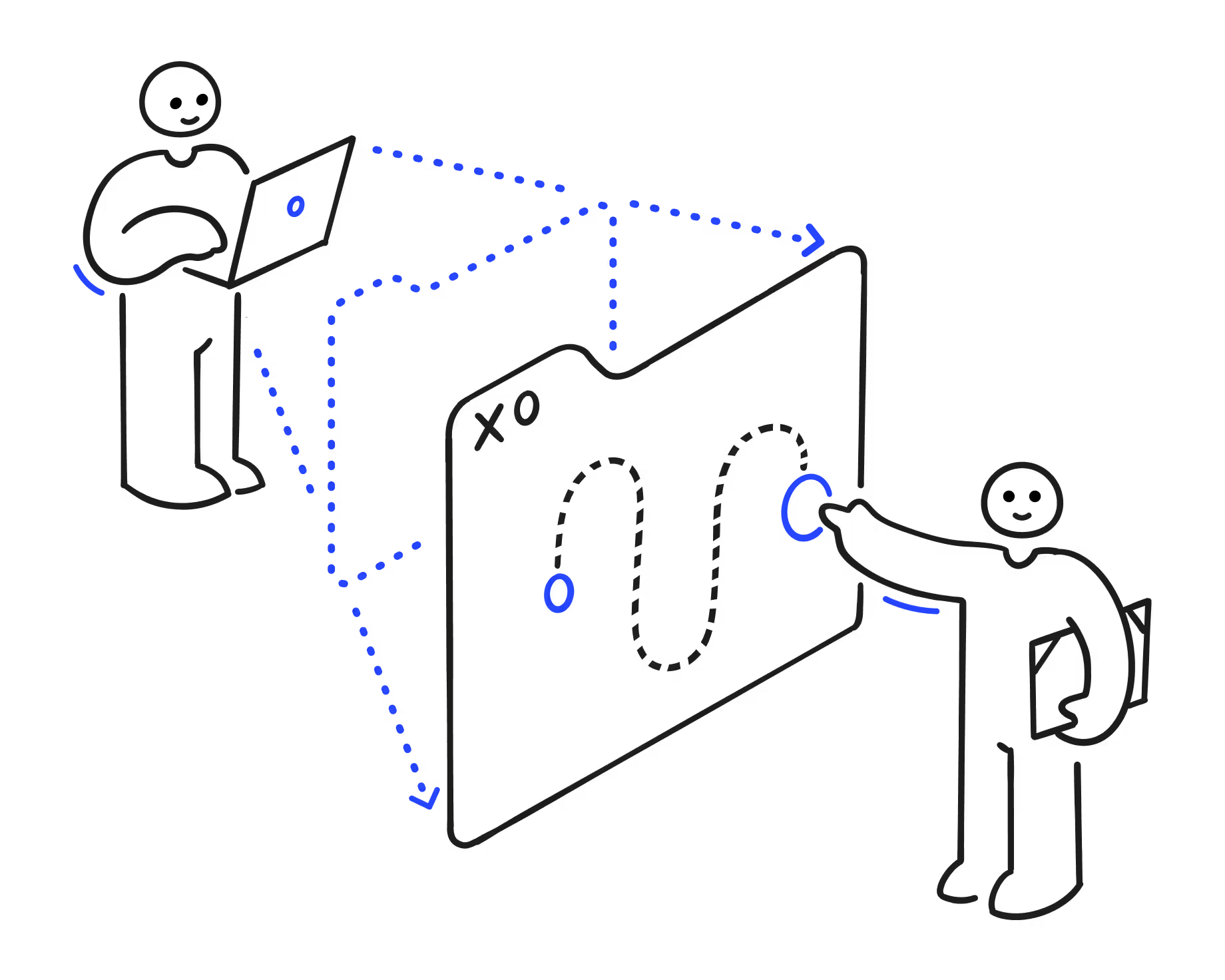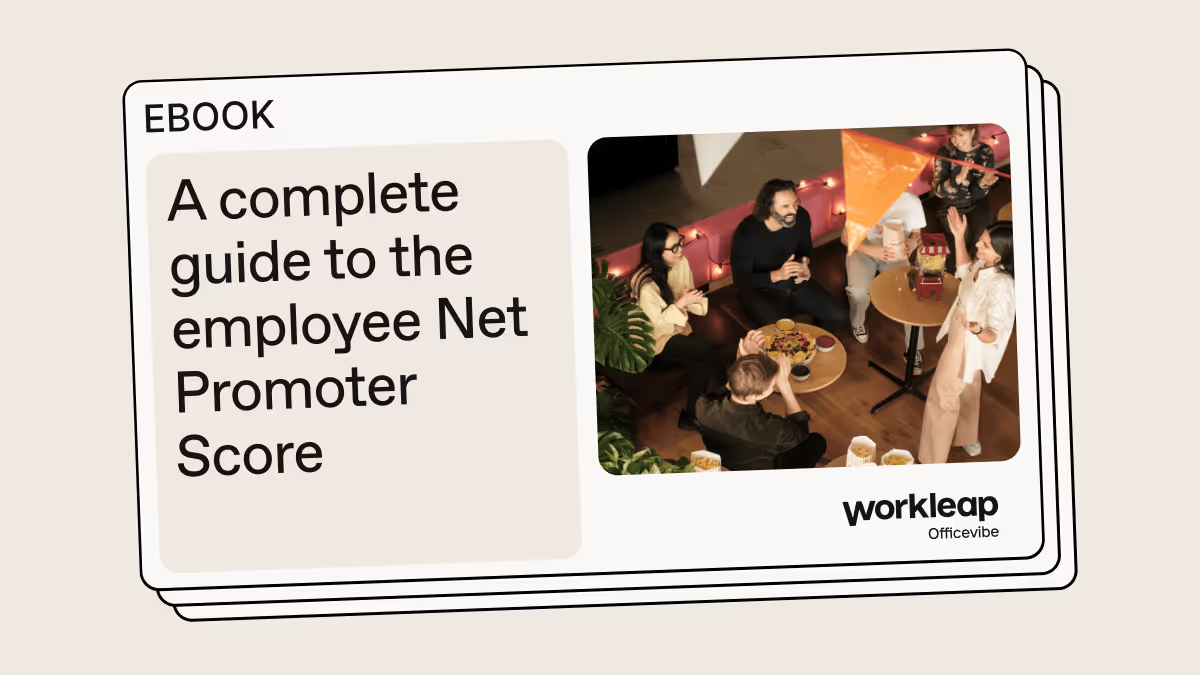The essential guide to employee satisfaction metrics

Discover Workleap Officevibe's benchmark report on 12 key employee engagement metrics

When did you last check on how your workers are feeling? Regular check-ins allow you to monitor happiness levels, show you what’s working, and when you need to intervene. If you’re not tracking employee satisfaction metrics, you’re missing essential insights that could level up your workplace.
Tracking your team’s happiness will help you keep them engaged and avoid costly turnover. In this guide, we’ll show you how to track and use this information to support business growth.
What’s employee satisfaction?
Employee satisfaction is how happy your workforce is at your organization. Various factors might impact their satisfaction level, from company culture to the nature of their work.
Employee satisfaction vs. job satisfaction vs. employee engagement
Employee satisfaction refers to a team member’s overall happiness with a work environment, while job satisfaction is more specific, focusing on the enjoyment someone takes in their role. A job satisfaction example is an employee who takes pride in their day-to-day tasks.
Employee engagement goes beyond happiness and measures how aligned workers are with the company’s purpose and how motivated they feel to perform their duties. Engaged teams care about organizational goals and are more likely to feel pride in the company’s successes. Employees tend to be more satisfied when engaged, and vice versa, but it's worth measuring each separately to paint a fuller picture of how your team is doing.
Why measuring employee satisfaction matters
Focusing on employee satisfaction metrics makes good business sense. When people feel fulfilled and supported at work, they show up with energy, motivation, and a stronger sense of purpose.
Tracking satisfaction gives you a clear view of what’s working and where you need to make improvements. It also helps you spot early signs of disengagement, so you can act before turnover becomes a problem.
Key employee satisfaction KPIs and metrics
Since employee satisfaction tracks your team’s feelings toward their role and the organization, it can be tricky to quantify. So how do you measure employee satisfaction? The following employee satisfaction key performance indicators (KPIs) make analysis easier:
Employee net promoter score (eNPS)
An employee net promoter score (eNPS) measures satisfaction by asking how likely employees would be to recommend your workplace. A high eNPS means your team would happily promote the company to friends and professional peers.
Monitor your eNPS by surveying employees. Ask them to score the workplace on a scale of one to 10. Those that score you highly (nine and up) are labelled “promoters,” and low scorers (under six) are “detractors.” Calculate the percentage of promoters and detractors at your organization and subtract them from one another to get your eNPS.
Employee satisfaction index (ESI)
An employee satisfaction index (ESI) tracks employee happiness at your company through a series of survey questions. The higher your ESI score, the happier your workers are. Routinely calculate your ESI to monitor improvements and setbacks over time.
Ask employees to rate their satisfaction on a scale from one to 10. Take the average, divide it by the highest potential score—so 10—and multiply by 100 to get a percentage. For example, if the average score was eight out of 10, the calculation would be (8 ÷ 10) x 100, resulting in an 80% ESI rating.
Voluntary turnover rate
Voluntary turnover is the rate at which employees decide to leave the company. (Involuntary turnover occurs when management lets someone go as a result of downsizing or firing.) Employees often leave because they’re unsatisfied at work, so voluntary turnover rate can be a powerful satisfaction metric.
Calculate your rate by dividing the number of employees who quit over a specific period by those who remained. Then, multiply by 100 to get a percentage. If 10 out of 100 employees left in a year, you would have a 10% annual voluntary turnover rate.
Retention rate
The flip side of turnover rate is retention rate, which reflects how many employees stay at your organization. A higher retention rate means fewer departures, but it’s important to consider this alongside other metrics to ensure employees are truly satisfied.
To calculate retention rate, first define a measurement period. Then, divide the number of employees who stayed for that entire period by the number at the start. Multiply by 100 to get a percentage. Say your company had 150 people at the beginning of the year, with 120 staying until the end. Your annual retention rate calculation would be 120 ÷ 150 x 100, resulting in 80%.
Absenteeism
Absenteeism is unplanned absences and last-minute requests for time off. A spike in absent workers can be a warning sign of a drop in employee satisfaction.
Have leadership check in with people who frequently miss work to find out why. But remember, if trust in leadership is low, employees may not speak honestly for fear of backlash.
Manager effectiveness index (MEI)
A drop in employee satisfaction may correlate with poor communication, organization, training, and recognition from leadership. Determining your company’s manager effectiveness index (MEI) can offer important clues about management’s relationship with employees.
Gather relevant data from workforce surveys and managers’ performance reports to gauge their effectiveness.
4 extra ways to measure employee satisfaction
If you want to dig even deeper, these workplace satisfaction survey techniques can help capture both qualitative and quantitative data.
Pulse surveys
Pulse surveys are quick and frequent questionnaires. They tend to focus on a few key topics and take employees just a few minutes to complete.
Pros
- Pulse surveys are fast, meaning your team can complete them whenever they have a free moment
- Quick questionnaires combat “survey fatigue”
- You gain information on a rolling basis and can quickly implement an action plan for change
Cons
- These surveys don’t paint a full picture of employee satisfaction, so it’s wise to pair pulse surveys with other methods
Annual surveys
Annual surveys contain targeted questions on a wide variety of subjects. Employees need time to complete these questionnaires, so be sure to build it into their schedules.
Pros
- Annual surveys provide a comprehensive overview of employee satisfaction, so you’ll have plenty of data to analyze
Cons
- The long time between surveys means day-to-day issues can be overlooked
- Lengthy surveys may result in “survey fatigue,” meaning employees may put off answering or give short responses
One-on-one meetings
A one-on-one meeting is a feedback session between a manager and an employee. While this is mainly a time for praise or constructive criticism, it’s also an excellent opportunity to ask how happy they are at work.
Pros
- Leaders can gather direct feedback about employees’ experiences
- Managers can ask for clarification on the employee’s feedback in the moment
Cons
- One-on-ones are a slow way to collect information, so if you need a lot of data at once, opt for a survey instead
- Employees may not always feel comfortable sharing this information with their direct managers, which makes it difficult to detect and address satisfaction issues.
Focus groups
Focus groups gather several employees to provide feedback collectively. A leader guides the talk, but the goal is to remain flexible enough to gather commentary naturally.
Pros
- A group environment can encourage even shy employees to speak up
- You can gather insights from a cross-section of people with different points of view
Cons
- Strong voices can dominate the narrative, drowning out some people’s opinions
Employee satisfaction measurement tools: Features to look out for
There are many excellent tech-driven survey and data-gathering tools to streamline employee satisfaction monitoring. Before choosing one, make sure it has these basic features:
- Anonymity controls: Employees will want to be reassured that their responses are confidential.
- Dashboards and reports: These features automate calculations and graphing, making it easier to visualize data.
- Customizable surveys: Being able to customize questions allows you to tailor surveys to your specific workplace.
- Integration: To support survey distribution, check that the platform works with Slack, Microsoft Teams, and any other relevant tools.
Here are a few great tools to help you gather meaningful insights.
Workleap Officevibe
Workleap Officevibe is the premier option for small and medium-sized teams. With Officevibe, you can create custom, anonymous surveys and leverage the platform’s AI-driven insights to chart a course forward. The solution’s intuitive dashboard helps visualize workplace issues so you can tackle them quickly and easily.
SurveyMonkey
SurveyMonkey lets you customize surveys and send them securely. The app gathers and presents results in a dashboard and performs basic analytics. But it lacks specialized features for ongoing engagement tracking and manager enablement, which can limit its long-term impact for HR teams.
Google Forms
Google Forms is a solid, free option for the budget-conscious. It allows you to collect data through anonymous, customizable surveys and visualize it in simplified pie charts and graphs. That said, it’s not built for performance or engagement tracking, which means HR teams often end up doing more manual work to extract insights and act on feedback.
Use metrics to improve employee satisfaction
You’ve collected employee satisfaction metrics, but that’s just the start. Now comes the time to turn those insights into change. Here’s how.
Share results with your community
Satisfaction metrics shouldn’t be a secret. Present the data to your workforce so people know you’re listening. This also lets you explain any proposed interventions and implementation plans.
Make high-impact action plans
Create an action plan with clear milestones and a defined timeline. Address the most pressing, high-impact issues first to avoid taking on too much at once.
Train leadership
Continually train your leaders. Teach active listening and healthy communication techniques and show them how to give and gather more meaningful feedback.
You should also encourage managers to empower employees to work autonomously. When workers are granted responsibility for their own schedules and tasks, they feel empowered and respected.
Boost engagement with Officevibe
When people feel valued and heard, great work naturally follows. Tracking satisfaction helps you spot what’s working (and what’s not), so you can make meaningful changes before issues grow.
Workleap Officevibe brings those insights to life with simple pulse surveys, AI-powered analytics, and peer recognition tools that help every manager support their team.
Demo Workleap today to see how it can help monitor and transform the employee experience at your organization.
Give HR and managers the clarity, confidence, and connection to lead better every day.


%20(1).png)


.png)
.png)







